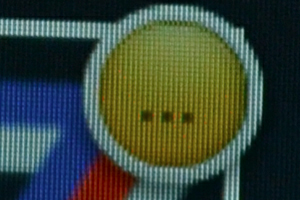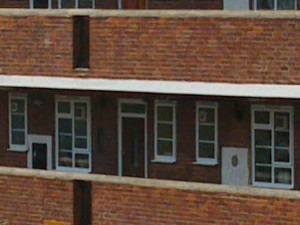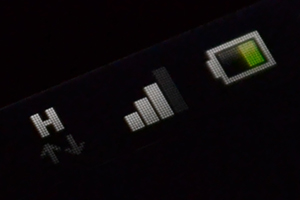The Xperia P is the mid-range entry in Sony's Xperia NXT series of smartphones announced at MWC earlier this year. It sits below the Xperia S and above the entry-level Xperia U. Sony's strategy with this trio of handsets invites comparisons to HTC's One Series: both aim to address the low-, mid-, and high-end of the smartphone market with devices that share a common design philosophy.


DESIGN & HARDWARE
The Xperia P is a very attractive, flagship-quality device. Superficially, it looks like Sony has shrunken the Xperia S' shell to fit around a smaller display. Sure, it's still a black slab divided in two by a transparent sliver of plastic, but look closer and there are some subtle differences between the two.
The important thing is that it’s sturdy, and whichever process Sony has put the aluminum through leaves it feeling very smooth in your hands. Unfortunately, the black portion below the transparency is made from plastic, which reflects light differently from the upper section and may thus annoy perfectionist.
The front of the device houses a precisely-inset 4-inch qHD WhiteMagic LCD, a front-facing VGA camera, a notification light, and a row of three capacitive buttons set inside the aforementioned transparency. One annoyance with the Xperia S was that its icons weren't actually buttons, so it's good to see Sony use some sense this time around. There’s taut haptic feedback from the capacitive buttons when pressed, and they’re also very easy to find in any light. Extra points are earned for the good distance between the screen and capacitive buttons, which makes accidental presses an impossibility.
Centered in a vertical strip along the back you'll find the LED flash, an 8-megapixel camera, and the old Sony Ericsson "liquid" logo. The first two are joined together by a thin etched line, which appears to be an attempt at adding some panache to the Xperia P’s barren features, but just comes across as a bit odd. The Xperia logo can be found at the base of the phone on both sides and is pretty inoffensive as far as branding goes.
On the right side you'll find a loudspeaker, a power button, a volume rocker, and a shutter key. There’s simply too much stuff in such a small area. On the opposite side there's Micro USB, Micro HDMI, and a spring-loaded Micro SIM card slot that’s protected by a flimsy plastic cover. The buttons feel solid, especially the two-stage shutter key, which is without a doubt the best I've used on any phone.

Because of the over-ladened sides, the top and bottom of the device are almost completely empty — up top there’s a headphone port, down below, the microphone. The headphone port is upsetting: it's set off-center and so close to the edge of the phone that most headphones will sit wider than the phone itself. It’s a purely visual thing, but everyone that’s seen the Xperia P has noticed it without my prompting them, so it’s not just pedantry at play here.
DISPLAY
WhiteMagic is so much more than just a bad name

Sony says that this display saves up to 50 percent of backlight power in low-light conditions by allowing pure light through the white pixels. In addition, WhiteMagic technology can be used to up the display’s brightness, all the way up to 935 nits, which Sony claims is double the brightness of an average LCD. That's a great statistic to show off, but what does it actually mean for the usability of the device? Put simply, in daylight, the Xperia P’s display is hands-down the most readable smartphone display I’ve ever come across. Even in direct sunlight, text remained entirely legible and colors were still accurate.
SOFTWARE
Sony's current Gingerbread skin is light and well organized. There's a whole suite of custom widgets, some of which are great, if a little flashy for my tastes. The gallery carousel widget is probably the standout, along with a handy set of eight toggles for wireless, radio, and sound settings. However, there are many that are unneeded, unwanted, and impossible to remove — something which unfortunately also applies to pre-installed software.
The non-removable app list is as follows: Connected Devices (DLNA), Timescape (Social Networking), Setup Guide, Facebook, Music Unlimited, Video Unlimited, TrackID (Shazam alternative), and Recommended (a curated list of apps that links to Google Play). There's one question that comes to mind — why? I can understand Music Unlimited and Video Unlimited being non-removable — Kaz Hirai's One Sony should be offering all of its services on every device it ships. The others vary from useful (DLNA media streaming functionality out of the box is always nice) to utterly useless (Recommended).
The lockscreen is a simple slider — swiping from left to right unlocks and from right to left toggles sound / vibrate modes. It also offers one-line previews of messages as well as notifications for missed calls and voicemails, all of which can be swiped to the right to enter the appropriate application. While there's nothing particularly novel about the idea, the notifications stack from the bottom, look great, and are particularly unobtrusive — I hate being bombarded by huge boxes every time I turn on my phone.

CAMERAS
The Xperia P's f/2.4 8-megapixel camera is fantastic and holds its own against Samsung and Apple's best efforts. Photos are crisp and detailed, and even at full crop display a surprisingly low amount of noise for a smartphone camera. It's good enough to replace a mid-range point-and-shoot camera in almost every circumstance.
When the Xperia P is asleep, holding the shutter key will automatically power on the device, autofocus, and take a photo in around a second. You can also set it to boot to the camera app without taking a photo, but I found the instant shot feature far more useful.


You'll shoot usable photos in almost any light, and although noise will get progressively worse as the software cranks up the ISO, the results are better than most. The Xperia P's LED flash also performs admirably, and although it still over-exposes nearby objects a little, it rarely ruins a photo. The front-facing VGA camera isn't much use besides video calling, but it at least copes quite well in low-light situations, handy if you want a late-night Skype session.
Movies are recorded at 1080p and are generally very good. No matter how quickly you move the camera, jerks and wobbles are kept to a minimum and the image stabilization works almost flawlessly. You may see an occasional distortion or jumpy moment, but they're so rare it's basically a non-issue. My only real gripe is with the autofocus. It generally works well but there are occasional moments where you'll end up waiting a good second or two for it to realize it's out of focus. The natural solution would've been to set the shutter key to refocus with a half-press. I've deliberately chosen clips that suffer from focusing issues so you can see a worst-case scenario.
If you're serious about mobile gaming, look elsewhere
Coming into this review I was concerned about how the Xperia P's tiny 1305mAh battery would cope, but its SoC seems relatively good at sipping power. The Xperia P managed around 14 hours of use, including an hour and a half of camera work, watching a two-hour video, two hours of gaming, and over an hour of calls. In reality it’ll get you to the end of the day without any issues, and if you're not a heavy user you'll get a couple of days out of it.

3G PERFORMANCE
Reception and call quality were also top-notch, and no one I spoke with had any complaints. The loudspeaker and mic both performed admirably when in speakerphone mode. There’s been an iPhone 4-style signal-killing "death grip" reported on recently, which I did my best to replicate. While I succeeded in dropping some bars, it's very difficult to trigger by accident, and, in an area with good signal, doesn't even prevent you from making a call — much ado about nothing, as a number of phones suffer from the same issue. Data speeds on 3G maxed out at around 7.4Mbps down and 2.2Mbps up, which is almost identical to the speeds you'll find on the iPhone 4S, Galaxy S II, or pretty much any modern smartphone.
SUMMARY
.JPG)
Source : The Verge